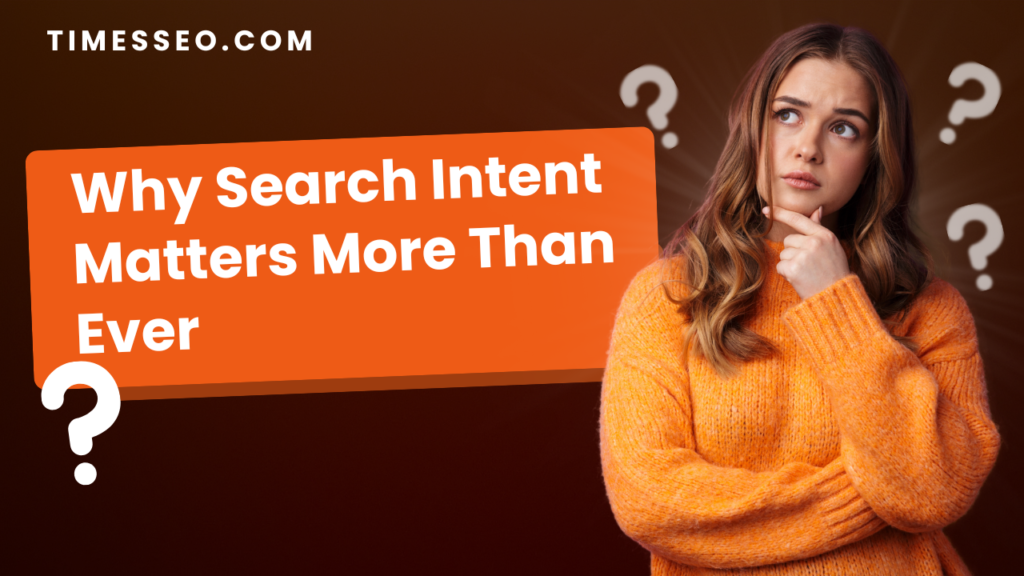
Writing SEO‑Friendly Blog Posts That Align with Search Intent
Master the art of writing SEO-friendly blog posts that align perfectly with user search intent. This post explores how to identify intent types, structure content effectively, and drive higher rankings and conversions through intent-based blogging.
Table of Contents
Introduction
What Does SEO-Friendly Really Mean?
Being SEO-friendly means more than stuffing keywords into a post. It’s about crafting content that’s easy for search engines to understand and users to love. It means your article has the right structure, keywords, formatting, and—most importantly—matches what users are really searching for.
Understanding Search Intent in 2025
With algorithm updates happening regularly, Google’s smarter than ever. It’s no longer just about “what” someone types—but “why” they typed it. Search intent is the secret ingredient to making your blog post rank, convert, and connect.
Why Search Intent Matters More Than Ever
Google's Priority Is User Satisfaction
Google’s #1 mission? Deliver the most relevant result to every query. No matter how nicely your blog is written, it will be difficult to rank if it doesn’t align with the intent behind a term.
Matching Content to Intent Increases Conversions
People find what they want faster when your content solves their exact need. Whether they want answers, comparisons, or products—your post should deliver it clearly and quickly.
The Four Types of Search Intent
Informational Intent
People are looking to learn something. Examples:
- “How to write SEO blogs”
- “What is search intent?”
Navigational Intent
They already know the brand or site they’re looking for. Examples:
- “HubSpot blog login”
- “Ahrefs pricing page”
Transactional Intent
The user is ready to take action (buy, subscribe, download). Examples:
- “Buy SEO tools online”
- “Sign up for content marketing course”
Commercial Investigation
They’re weighing options before buying. Examples:
- “Best blog writing tools”
- “Ahrefs vs SEMrush comparison”
Anatomy of an SEO-Friendly Blog Post
Keyword Placement and Optimization
Use your focus keyword in:
- Title
- First paragraph
- Meta description
- At least one subheading
- Alt text of images
Clear Structure with H1–H4 Tags
Break your content into sections that guide both readers and crawlers through the page. Use bullets, lists, and bolding for readability.
Engaging Meta Titles and Descriptions
They’re your first impression in Google search. Make them click-worthy and relevant to intent.
Mobile-First and User-Centered Design
Most users are on mobile. Make sure your blog is fast, readable, and scroll-friendly.
Aligning Blog Content with User Intent
Identifying Intent Behind Keywords
Check what already ranks for your target keyword. Are the top results:
- Blogs?
- Product pages?
- Videos?
- Listicles?
Let the SERPs tell you what Google favors.
Mapping Keywords to Content Formats
- How-to = guides, tutorials
- Buy now = product pages
- Best of = listicles and comparisons
Examples of Intent-Aligned Blog Posts
- Keyword: “how to clean sneakers” → Step-by-step tutorial
- Keyword: “best sneakers for flat feet” → Comparison guide
- Keyword: “buy white sneakers” → Product or category page
How to Write for Each Search Intent
Writing for Informational Searches
Focus on being clear, helpful, and educational. Use headings, steps, visuals, and FAQ sections.
Writing for Navigational Searches
Ensure your blog clearly references the brand or resource they’re looking for, with helpful context or alternatives.
Writing for Transactional Searches
Include strong CTAs, benefit-driven headlines, and product/service details. Keep conversion top of mind.
Writing for Commercial Investigation
Provide honest comparisons, pros and cons, and highlight use cases. Help readers make a decision.
Tools That Help You Analyze Search Intent
Using Google SERPs
Just type your keyword in and examine:
- Page types ranking
- Common titles
- People Also Ask boxes
Ahrefs, SEMrush, SurferSEO Insights
These tools often suggest search intent labels and help you analyze competing content.
AI Tools for Intent Classification
Tools like Keyword Insights, Clearscope, or MarketMuse use NLP to understand how content aligns with intent.
Content Format Based on Intent
Blog Posts
Great for informational and comparison content.
Product Pages
Ideal for transactional queries like “buy,” “order,” or “cheap.”
Comparison Guides
Perfect for commercial investigation queries.
Tutorials and How-To Articles
Answer “how” and “why” questions clearly and concisely.
Internal Linking and Search Intent
Link Supporting Content Together
Use blogs to link:
- Informational → Commercial pages
- Blog → Product page
- Comparison → Sign-up
Guide Readers Deeper into the Funnel
Help users move from awareness to conversion by suggesting the next logical page to visit.
Optimizing for Featured Snippets and Voice Search
Structure Answers Clearly
Use numbered lists, tables, and direct Q&A style formatting to improve chances of earning a snippet.
Use Natural Language and Conversational Tone
Think about how someone would speak a search:
“Hey Google, how do I write SEO blogs?”
Metrics to Track Intent-Driven Content
Bounce Rate and Dwell Time
Low bounce = intent matched
High dwell = content value delivered
CTR and Conversion Rate
Good meta = better click-throughs
Good content = higher conversions
Ranking for Intent-Focused Queries
Monitor keyword clusters around intent, not just one focus keyword.
Case Study: From Low Traffic to Targeted Visitors
Real-Life Example of Search Intent Optimization
A digital agency rewrote its blog titles and CTAs to match intent. Results in 90 days:
- Organic traffic doubled
- Bounce rate dropped 40%
- Leads increased by 60%
Step-by-Step Results and Traffic Growth
- Step 1: Audited old blogs
- Step 2: Aligned format with intent
- Step 3: Added better internal links and CTAs
Mistakes to Avoid When Writing Intent-Based Content
Ignoring Intent in Favor of Volume
A keyword with 10,000 searches means nothing if it doesn’t match your offer.
Over-Optimizing Without Value
Avoid fluff or overuse of keywords. Always prioritize reader clarity.
Creating One-Size-Fits-All Content
Tailor each post for one clear intent, not a mix of everything.
Future-Proofing Your Blog Strategy
Semantic SEO and AI Understanding
Google understands synonyms, entities, and concepts. Use natural, contextual phrasing.
Voice Search and Intent Clarity
People speak differently than they type. Create content that sounds conversational and natural.
Conclusion
Writing SEO-friendly blog posts is no longer about just inserting keywords — it’s about delivering the right content to the right people at the right time. When you align your blog posts with search intent, you win more traffic, gain higher rankings, and serve your audience better.
Frequently Asked Questions
Look at the top-ranking results in Google and analyze their content type and format.
While possible, it’s best to focus on one primary intent per post for clarity and SEO strength.
How-to guides, tutorials, FAQs, and listicles work great for informational queries.
Review and update intent alignment at least every 6 months, or when traffic drops.
Yes. Voice search often reflects conversational or question-based intent, so structure your content accordingly.
Table of Contents
Popular Posts
-
 Affordable Technical SEO Audit for Small Business: A Complete Guide26 Jun 2025 Blog
Affordable Technical SEO Audit for Small Business: A Complete Guide26 Jun 2025 Blog -
 How to Get an Affordable Technical SEO Audit for Small Business27 Jun 2025 Blog
How to Get an Affordable Technical SEO Audit for Small Business27 Jun 2025 Blog -
 The Ultimate Local SEO Audit Checklist for Startups28 Jun 2025 Blog
The Ultimate Local SEO Audit Checklist for Startups28 Jun 2025 Blog -
 Local SEO Audit Checklist for Startups: A Beginner’s Guide28 Jun 2025 Blog
Local SEO Audit Checklist for Startups: A Beginner’s Guide28 Jun 2025 Blog -
 Top On-Page SEO Audit Steps for Service Websites Every Business Should Know29 Jun 2025 Blog
Top On-Page SEO Audit Steps for Service Websites Every Business Should Know29 Jun 2025 Blog -
 Technical SEO for WordPress: The Ultimate Beginner’s Guide01 Jul 2025 Blog
Technical SEO for WordPress: The Ultimate Beginner’s Guide01 Jul 2025 Blog -
 The Impact of On-Page SEO Audit Steps for Service Websites on UX01 Jul 2025 Blog
The Impact of On-Page SEO Audit Steps for Service Websites on UX01 Jul 2025 Blog -
 Technical Mobile SEO Audit Tips for Developers02 Jul 2025 Blog
Technical Mobile SEO Audit Tips for Developers02 Jul 2025 Blog -
 Complete SEO Backlink Audit Guide for Better Google Rankings03 Jul 2025 Blog
Complete SEO Backlink Audit Guide for Better Google Rankings03 Jul 2025 Blog -
 Boost Your Rankings with Technical SEO for WordPress01 Jul 2025 Blog
Boost Your Rankings with Technical SEO for WordPress01 Jul 2025 Blog






